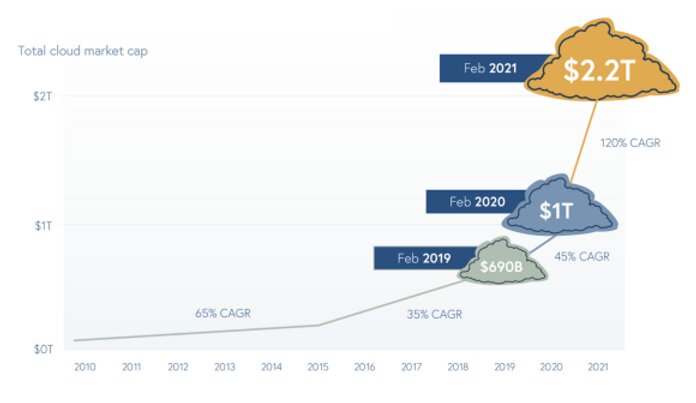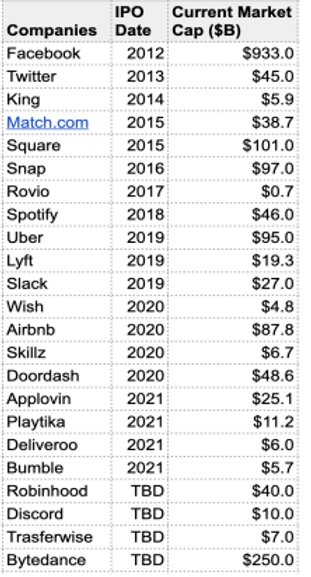Around 10 years ago, a typical startup had one hipster-looking iOS and/or Android mobile developer in the corner, while 10 or 15 web/cloud developers were taking up most of the space in the office. Now, this picture has reversed: at many companies, mobile development is taking center stage. After all, we now live by our mobile phones. Most people check their phones more than 60 times a day. We spend more time on mobile than on any devices, by a large margin.
Mobile’s inflection point was long coming, and now its dominance has been well established. This new mobile-dominant landscape will need specific tools to enable the millions of mobile apps that have taken over the world. In the last decade, a similar shift in the cloud led to many well-established cloud infrastructure unicorns, such as HashiCorp, Snowflake, Confluent, etc.


Source: eMarketer.

Source: Hootsuite.
Following suit, I think the mobile infrastructure unicorns are hatching right now.
The reason is that mobile is already mission-critical for many large enterprises, and many developers are building highly scalable applications that will be used by millions across the world. Gone are the days of simple early mobile apps. There’s now an army of mobile engineers building sophisticated applications—Snap, Airbnb, Facebook, etc. Mobile is now more than front-end only. Your backend infrastructure needs to be mobile aware i.e. connectivity is not always guaranteed. The cost of an hour of downtime ranges from a few thousand dollars to millions for companies like Uber. When stakes get this high, enterprises start to establish proper processes to deploy, manage, monitor and automate their development cycles.
Driven by this shift toward mobile tooling, we will see more demand for mobile infrastructure products/startups. Specialized products are necessary because mobile has fundamental technical differences compared to web/cloud infrastructure. The current tools fall short of automating the mobile backend for many reasons:
- First of all, mobile runs on Android or iOS, whereas web/cloud applications live on Linux and Windows. Those apps are built by different sets of languages—Swift, etc. These differences create a non-overlapping set of tools to configure, provision and manage the application infrastructure.
- Web/cloud apps are hardware agnostic, as most run on the browser, but mobile applications depend on the device (iPhone, iPad, android, etc.) and must share scarce resources with other apps to run smoothly. It becomes increasingly difficult to deploy and maintain high-performance mobile apps across the highly fragmented OS, device and form factor landscape.
- Mobile apps are hosted on the App Store or Play Store (or distributed via MDM.Not to mention the even larger app stores in Asia.), but you don’t get the broad set of solutions you’d get on AWS/GCP/Azure to manage, monitor, and update the mobile application. The app store approval process doesn’t allow for continuous delivery.
- There are mature telemetry technologies to extract all kinds of data to better monitor/observe your application in cloud/web environments. This is very complicated in the mobile world. Major cloud vendors can’t handle the cardinalities and scale of the time-stamped data.
In other words, as these apps increasingly serve millions of users across the globe, mobile development life cycles will need sophisticated tools, similar to web/cloud.
While mobile applications may continue to use some cloud-based services such as storage and compute, developers will need a specific set of mobile infrastructure solutions to deliver elaborate, scalable and reliable mobile applications. As a result, we’ll see a version of what happened with cloud infrastructure shortly happen with mobile infrastructure. There will be many tool companies to better serve growing mobile development teams at enterprises. Those teams will expect tools for CI/CD, continuous testing, orchestration, deployment and monitoring similar to what cloud/web environments have. We need the mobile corollaries to HashiCorp, Cloudbees, Datadog, and all the rest.
To see how big this opportunity truly is, look at the parallels between cloud adoption and mobile adoption, and compare the timelines side by side. Since the initial beta release of AWS (back then Amazon.com Web Service) in 2002 and shortly after its public launch in 2006, the cloud market led to an impressive amount of value creation across public cloud providers and the companies empowering them.

Source: BVP, 2021
A few years after cloud’s AWS moment, Steve Jobs changed the mobile landscape forever with the launch of the iPhone in 2007. Google followed quickly with the initial release of Android in 2008. Since then, there have been a number of highly valuable company creations—see the table. These are mainly US / EU companies that have substantial parts of their businesses derived from mobile apps or mobile web. Asia has even more skewed results with successfully mobile-first or mobile-only company exits.
 This is great, and there will be many others. However, the lack of large mobile infrastructure companies surprises me. How come cloud led to many infrastructure unicorns, whereas mobile, with its peculiar tech stack, hasn’t generated any? I believe it’s just a matter of time. We’re now about to see fast-growing startups that power the mobile infrastructure of all those mobile-first/mobile-only unicorns. Put another way: the mobile infrastructure unicorns are already here, hidden in plain sight. Here are some of the early movers that are showing the way:
This is great, and there will be many others. However, the lack of large mobile infrastructure companies surprises me. How come cloud led to many infrastructure unicorns, whereas mobile, with its peculiar tech stack, hasn’t generated any? I believe it’s just a matter of time. We’re now about to see fast-growing startups that power the mobile infrastructure of all those mobile-first/mobile-only unicorns. Put another way: the mobile infrastructure unicorns are already here, hidden in plain sight. Here are some of the early movers that are showing the way:
- Mobile Data Platforms: Data has become the core element of running any business. Data-centric enterprises utilize all kinds of data (customer, employee, financial, etc.) for analytics, business intelligence or machine learning purposes. The enterprise data stack has gone through an amazing transformation over the past few years, leading to the formation of impressive companies such as Snowflake, Segment, Confluent, Datadog, etc. In discussions with analytics or ML teams at various enterprises, I was surprised to hear the lack of mobile data used in AI or analytics or even observability use cases. The main reason is that mobile data is complex, and difficult to extract and transform. We invested in Embrace to address this growing blindspot in organizations. Embrace provides not only a comprehensive platform to extract and transform complex mobile data, but also an observability solution to help mobile teams handle unknown unknowns in their applications. This space will get more attention soon.
- Mobile Devops: I talked about the increasing need to automate the mobile development life cycle. Considering the growing complexity of the application and how much work it takes to maintain those, I believe we’ll see a growing ecosystem of players automating the mobile backend processes in addition to incumbents like Google Firebase. I like what Esper and Bitrise are doing here. Test automation , especially on the physical devices (vs simulator), could help uncover issues early. Headspin is an interesting company to watch here.
- Mobile AI: Running machine learning models on a highly fragmented device/OS landscape isn’t trivial. Today, developers rely mainly on the cloud to train and deploy those models. Companies like Fritz can enable mobile developers to run such models on the device so that users can experience AI services offline, fast and privately. In addition to mobile, we’ll see a growing number of smart edge devices that need to run ML models in various use cases ranging from security to connected cars to healthcare. Edgify is working on a compelling solution here.
- Mobile Front-end: Last but not least, UI/UX design for mobile applications is as important as the backend technology, if not more. Design becomes the core determinant of success for many of these mobile applications. This shift in the market will invite more automation and collaboration to the design process in the enterprises. Figma (designer tool) and Canva (graphic design for non-designers) have done an incredible job in enabling collaboration. We invested in Uizard that enables both design automation and collaboration for non-designers. They use their magical deep-learning powered technology to convert your scribbles and mockups into prototypes and apps.
I’m excited to see the emergence of new enabling technology players in the mobile development lifecycle. We’d love to support founders who are building innovative solutions in this evolving ecosystem. Please comment below if you have thoughts about this!


0 Comments